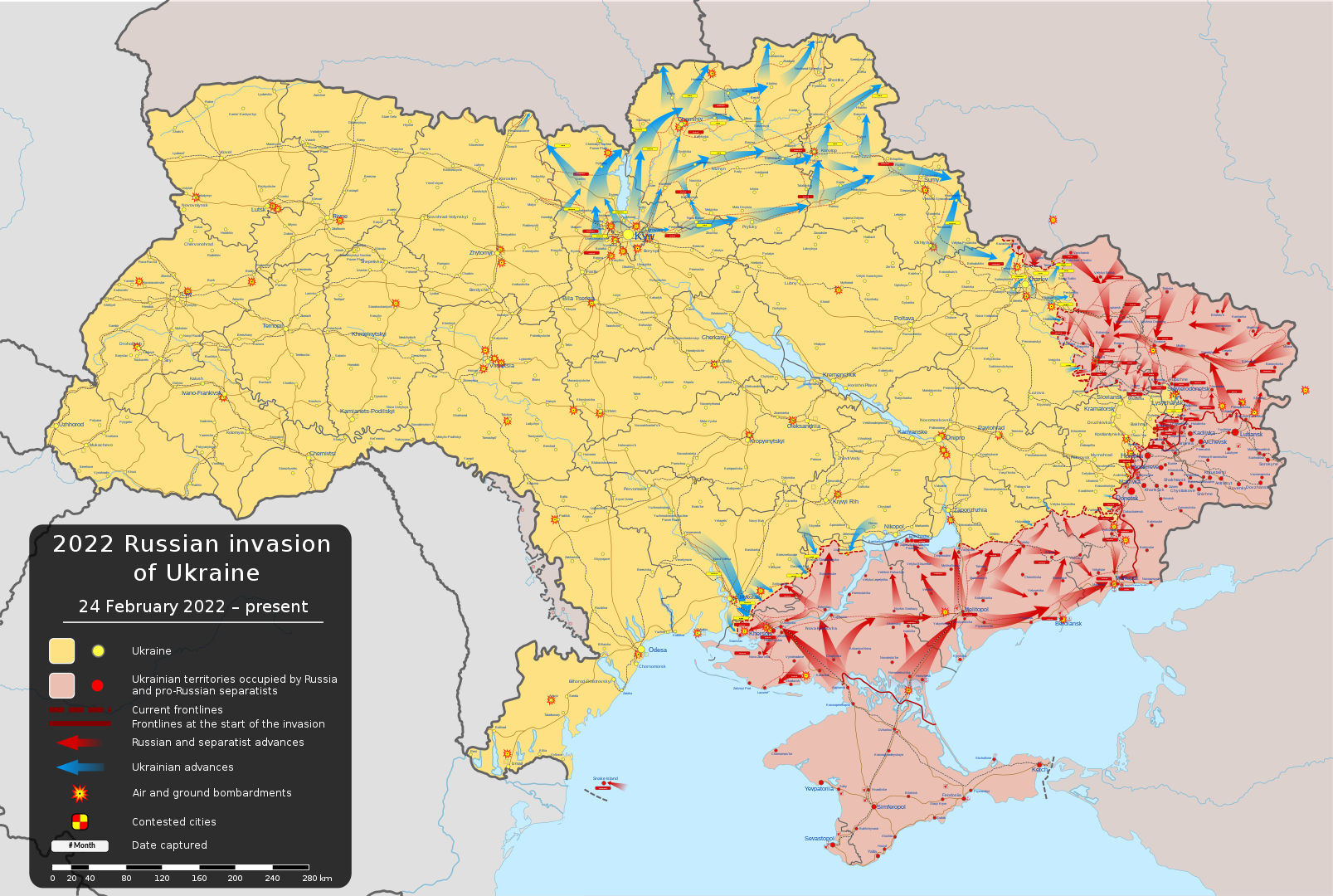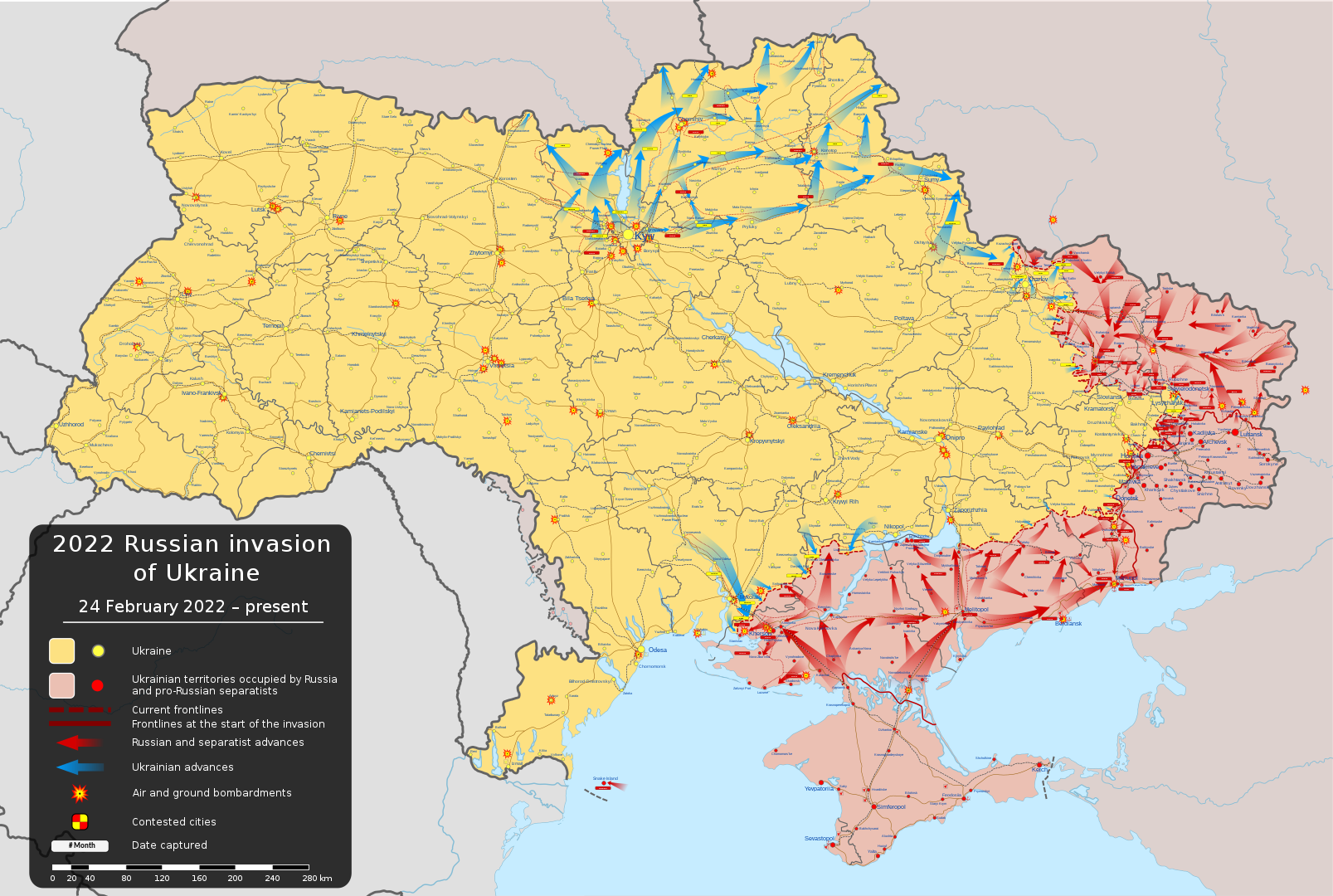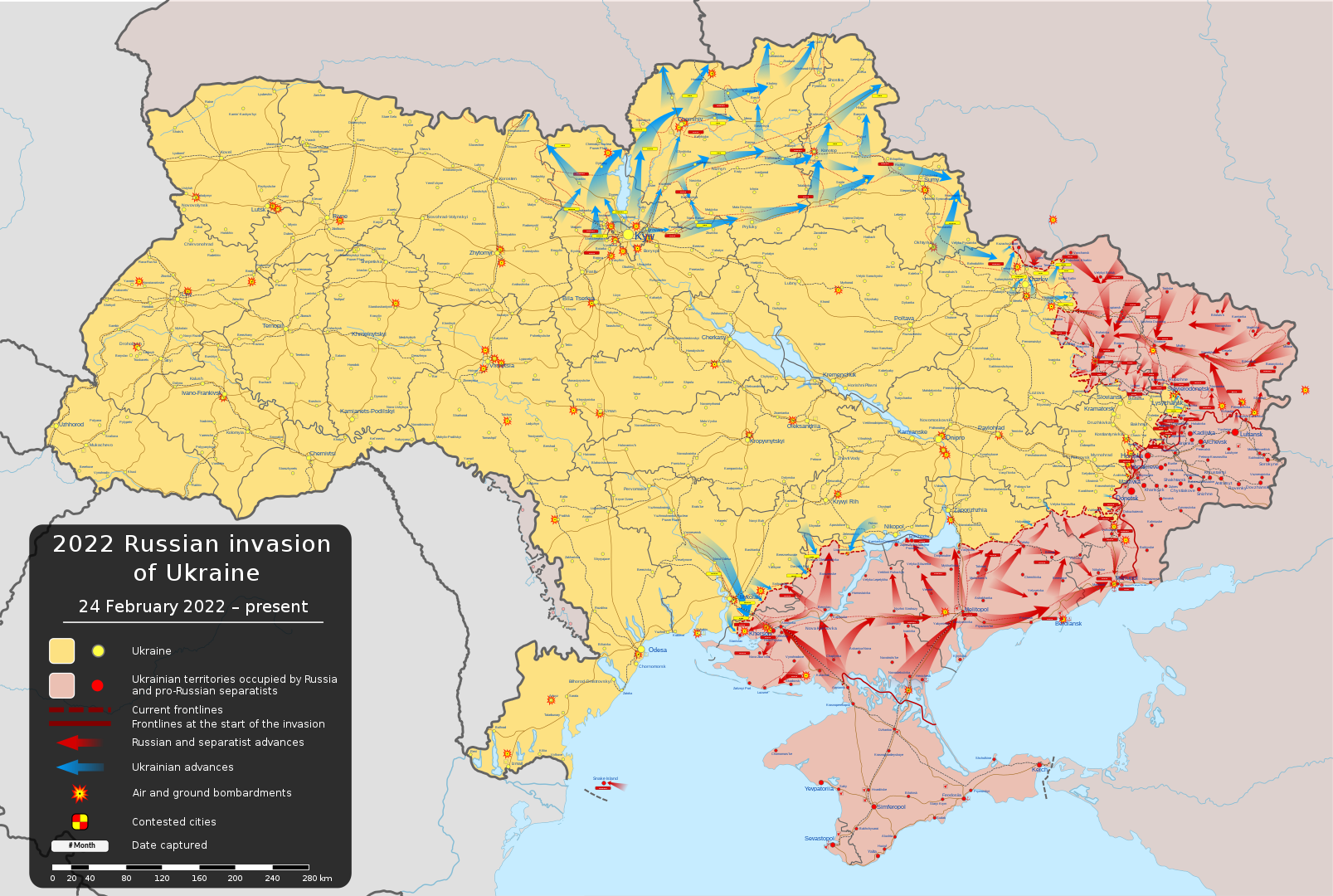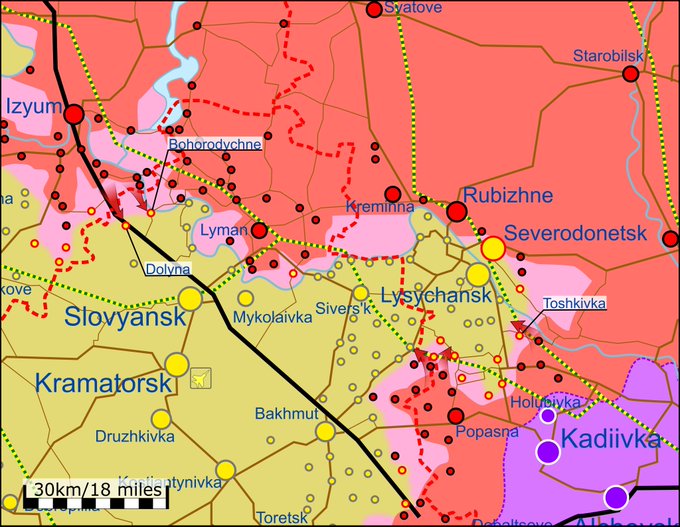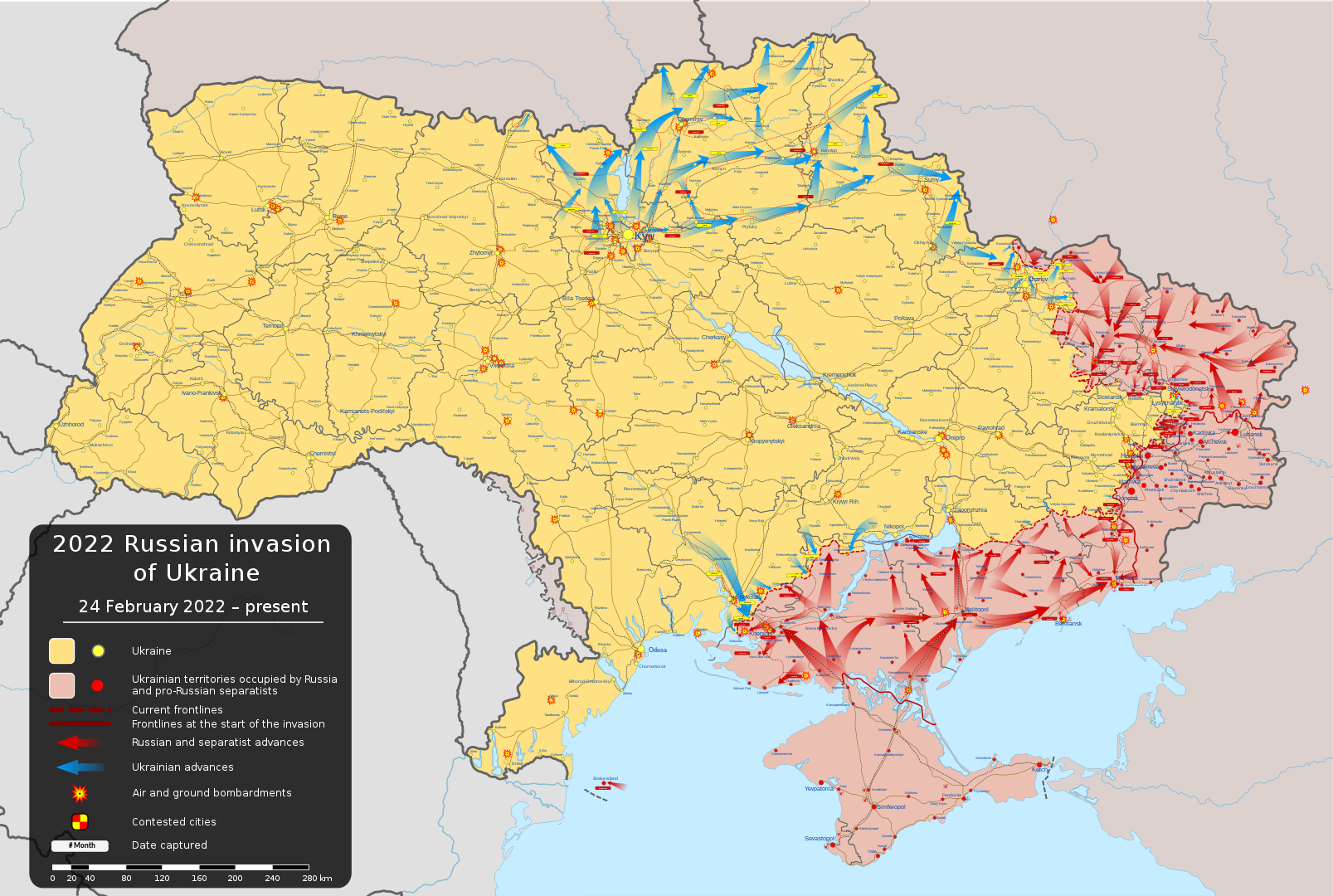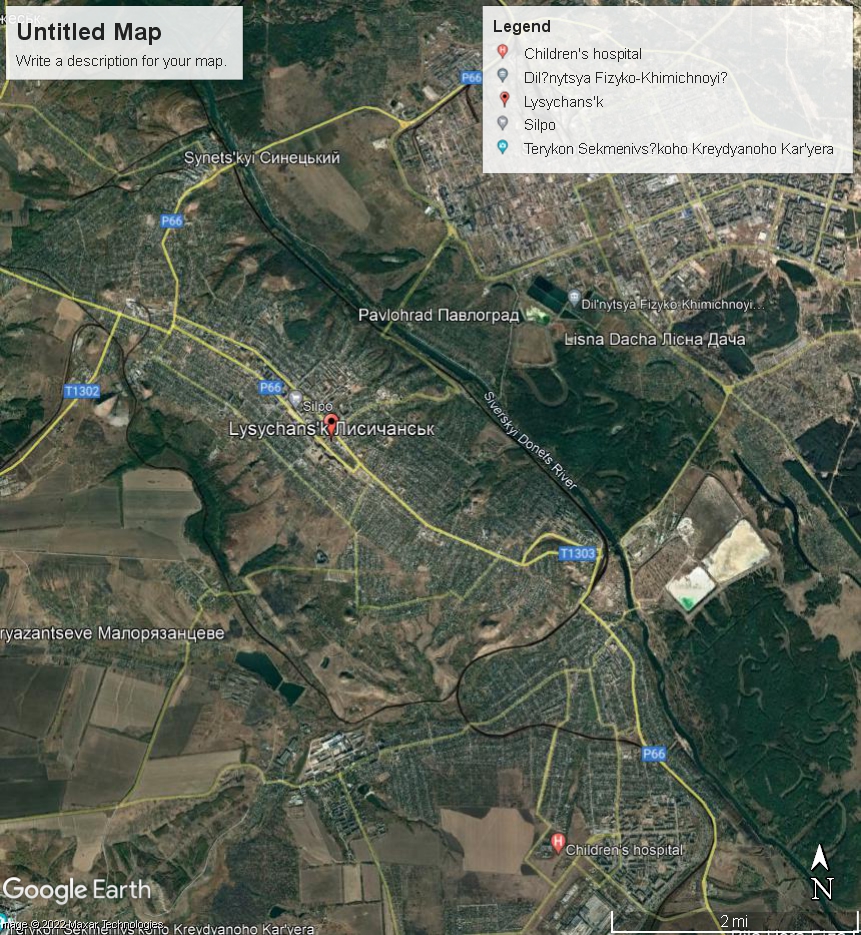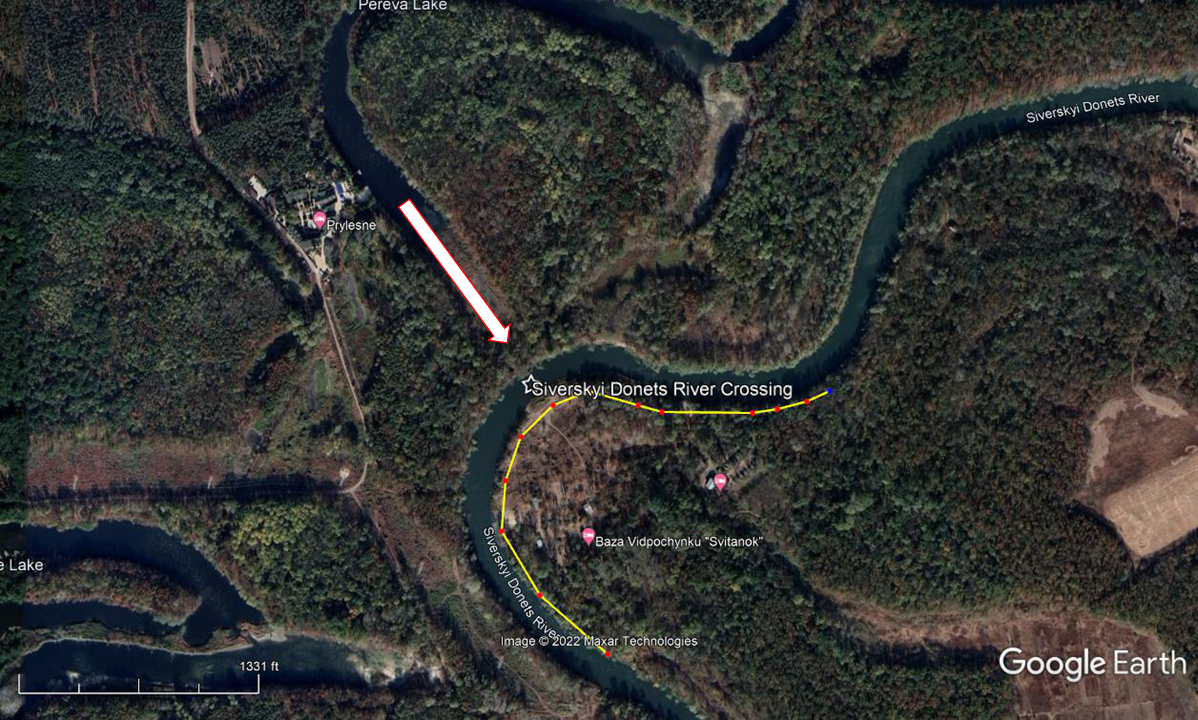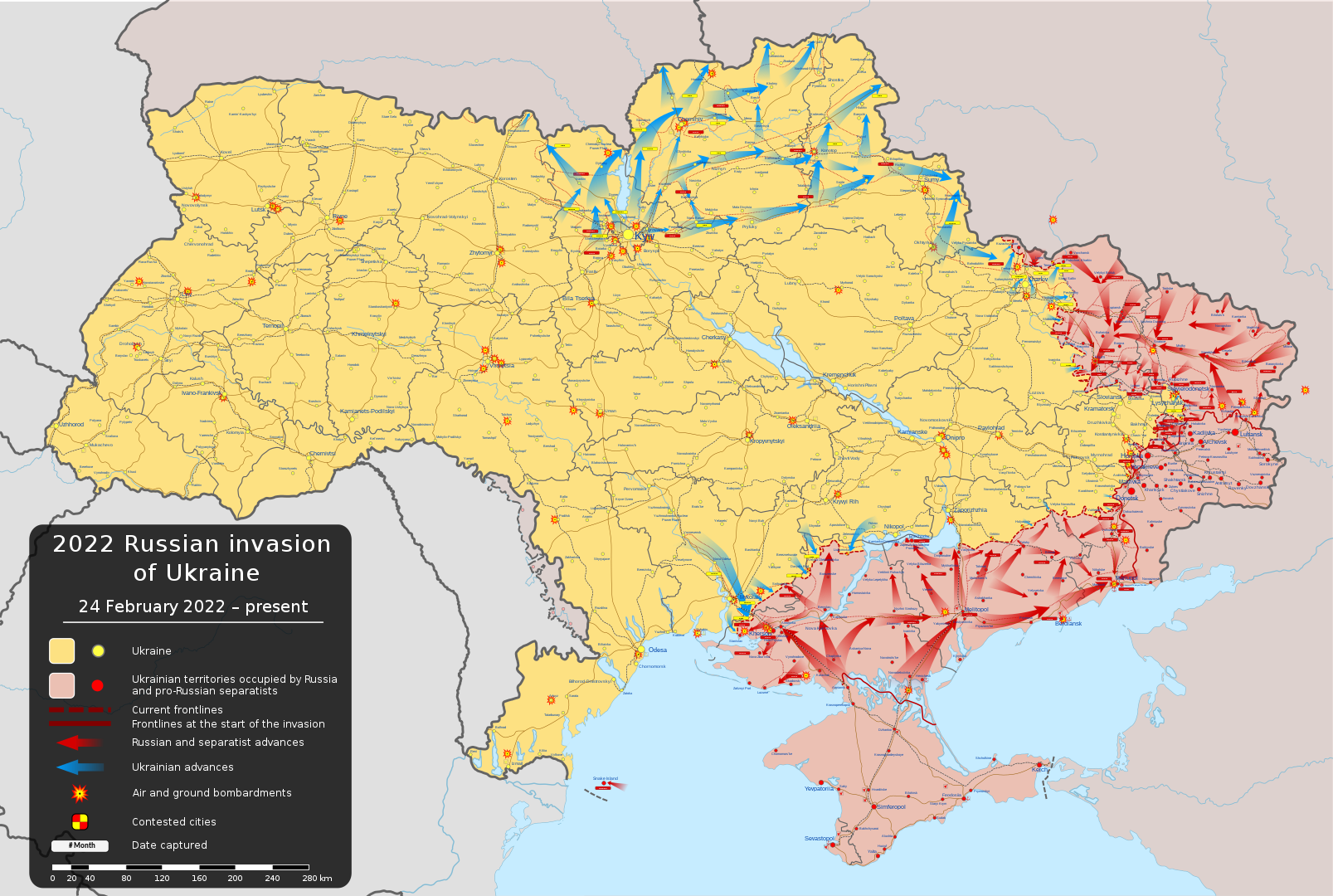
There is really nothing new to report on the ground since my last post on Friday. The situation has remained mostly unchanged for the last seven days. I do think that everything stalling out for a week is news.
About 80% of Severodonetsk is under Russian control. All three bridges across the river between Severodonetsk and Lysychansk have been destroyed, leaving Ukrainian forces in Severodonetsk a little isolated. Russia seems to be slowly taking Severodonetsk. As of 12 June Ukraine still controlled the eastern suburb of Metolkine. The Ukrainian forces are hanging on at the Azot chemical plant in the western part of the city. It has underground bunkers. It is another sprawling Soviet-era industrial facility similar to what we saw in Mariupol. It does look like Russia is going to take all of Severodonetsk. I am not sure that Lysychansk, in a well defended position, is in any threat of being taken this week or next week.
Other parts of the front have shifted back and forth. Fighting is still going on in around seven locales along the front. Russia continues expanding in control of the area to the north of Kharkov including having taken the village Vesele. In Lugansk/Donetsk area Russia threatens operations towards Barvenkove, towards Slovyansk from Izyum and Lyman, and around Popasna in addition to fighting in Severodonetsk. Russia has taken some territory to the west of Izyum and the fighting continues back and forth in that area. Russians threatens to advance to the north and NW of Slovyansk and threaten to cross the Severskii Donetsk River at Bohorodychne, just north of Slovyansk but nothing has actually happened in the last couple of days. South of Severodonetsk, towards Poposna, the Ukrainians retook part of the village of Toshkhiva. North of Popasna, the Russians took Komyshuvakha two weeks ago, took Vrubivka on 18 June, and threaten Zolote. Around Kherson, fighting continues in two areas, near Kherson and to the NE of Kherson. Last week Ukraine took Blahodatne to the NW of Kherson but Russia took it back this weekend. Ukrainian advanced last week took three villages in the area. There were other claims of advances closer to Kherson, but they do appear to have panned out. The Russians appear to have pushed back against the Ukrainian forces to the NE of Kharkov, indicating that the Ukrainian offensive there is completely stalled out. A worthwhile graphic discussion dated 16 June of where the front line lies is here (14:05 in length): https://www.youtube.com/watch?v=TjC1vSdf-oA.
There is some concern now that Ukraine seems to be on the downside of the casualty exchange, primarily because of overwhelming Russian artillery. Zelenskyy did state last week that Russians have a numerical advantage. It is stated in the Ukranian paper, “New Voice of Ukraine” that they are suffering up to 1,000 casualties a day in Donbas (a casualty includes killed, wounded and missing, so maybe 200 dead a day based upon this estimate). Ukraine is calling for more heavy weapons, in particular artillery and shells.
I will put any changes/updates since my last post in italics. A link to a blow up of the map is here: Wikipedia map. I have reduced the number of postings of these updates to three times a week (M, W and F).
The map below from 20 May is borrowed from Dr. Michael Mackay @mhmck. The area threatened with encirclement contain the cities of Sievierdonetsk and Lysychansk and surrounding areas which had a population in excess of 350,000. The expansion around Popasna is greater than what is shown here (see more detailed map in the Donbas discussion below).

Right now, Sloviansk and Kramatorsk appear to be secure. The four main cities in this area are Severodonetsk (pop. 101,135), Lysychansk (pop. 95,031), Sloviansk (pop. 106,972) and Kramatorsk (pop. 150,084). It appears that the war has been reduced to 1) a fight over Severodonetsk and Lysychansk and 2) maybe a fight over Kherson.
We have been looking at six major areas of operations. Only two appear to be active right now. Russia now occupies four cities, Mariupol (pop. 431,859), Berdyansk (pop. 107,928), Melitopol (pop. 150,768) and Kherson (pop. 283,649).
1. Kiev – secure
2. Odessa – secure
3. Kharkov – secure
4. The Donetsk and Lugansk provinces (the Donbas)
5. Mariupol – operations completed
6. Crimean border/Kherson
It appears that Kiev, Chernigov, Sumy and the northeast part of Ukraine are secure. Of course, Russia can always reintroduce troops later from Russia or Belarus. They are supposed to have around 20 BTGs in Russia. A Ukranian border guard was killed on 16 May near Sumy. The U.S. DOD is reporting that the Russian forces in Ukraine are now 106 BTGs.
Here is what I have heard/seen from open sources:
1. Kiev (pop: 2,962,180): It appears that Kiev is secure.
2. Odessa (pop: 1,015,826): Appears to be secure.
3. Kharkov (pop: 1,433,886): Kharkov looks to be securely held but is still being hit by both missiles and artillery. Russians are pushing back towards Kharkov, taking over the last couple of days the villages of Mali Prohody, Velkyki Prokhody (to the west of Lyptsi), Vesele, Male Vesele (to the SE of Lyptsi) and Borshchova (south of Lyptsi). They appear to have advanced part of the distance back towards Kharkov and continue to expand their control of the areas to the north of Kharkov
Map showing front lines near Kharkov on 27 April and 17 May (cribbed from @War_Mapper), with the 17 May map showing the taking of Dementiivka.


Now Russia appears to be reclaiming some of the territory between Lyptsi and Kharkov.
The Russian push to the southwest towards Barvinkove (pop. 8,110), vice the south or southeast, has been stalled out for weeks. It was either a broader encirclement of Slavyansk and Kramatorsk, or the rumored drive on Dnipro (which I really don’t believe they are going to try). Still, no villages have been reported taken in this area for the last few weeks. A video from Sky News from Barvinkove (3:58): Ukraine War: Ukrainian soldiers stand firm in Barvinkove. Trench warfare (2:14)?
The latest Russian efforts took the town of Svyatohirsk (pop. 4,309), which is 19 miles (30 kilometers) due north of Slovyansk and on the north bank of the Severskii Donetsk River. Russia is claiming to have “liberated” Svyatohirsk on 7 June. They have advanced to Bohorodychne (north of Slovyansk) and are threatening to cross the Severskii Donetsk there and are advancing some to the NNW of Slovyansk. The Russian have now taken most of the areas north of the Severskii Donets River. Another map cribbed from @War_Mapper dated 9 May.

The Ukrainians still have the river between them and Slovyansk.
4. The Donetsk and Lugansk provinces (the Donbas): The Russians currently hold most of Severodonetsk and appear to be on the advance. Next is Lysychansk, which is literally just across the Severskii Donets River from Severodonetsk. As of 12 June Ukraine still controlled the eastern suburb of Metolkine. These two cities are surrounded on three sides. According to Ukraine only 15,000 civilians remained in Severodonetsk and only 20,000 reman in Lysychansk. Lysychansk is on higher ground with a river in front of it and a large open, partly wooded area beyond it and puts Severodonetsk under fire. This could be the point where the Russian advance in this area stalls out because of terrain. All three bridges across the Severskii Donets in this area have been destroyed by Russia. This was probably to reduce reinforcements and resupply from Lysychansk into Severodonetsk, but it also works the other way. It appears that they are not going to assault Lysychansk from Severodonetsk. They may come at it from another direction, perhaps from Popasna.

The Ukrainian forces are hanging on at the Azot chemical plant in the western part of Severodonetsk. It has underground bunkers. It is another sprawling Soviet-era industrial facility similar to what we saw in Mariupol. Do not know what else they hold.
To the south of Severodonetsk, part of the village of Toshkhiva was retaken this weekend by the Ukrainians. The Ukrainian General Staff reported that they had achieved partial sucess, entrenching themselves in the northern outskirts. The Ukrainians retook Toshkivka on 29 May but lost at least part of it the following day. Ukraine were still reporting on houses lost at Toshkivka, so I assume they still held part of it.
Further south, the village of Zolote in still held by Ukraine, even though some reports claimed Russia took it on 23 May. The Ukrainian government is still reporting on 7 June that houses were destroyed in Zolote from shelling, which indicates that Ukraine holds it.
The danger of surrounding Severodonetsk and Lysychansk is coming from the Russian operations around Popasna (pop. 19,672), which has been in Russian hands since 7 May. They are threatening Bakhmut (pop. 72,310) and Soledar (pop.10,692). The Russian forces have advanced to within 10 miles (16 kilometers) of Bakhmut. The Russians have taken Komyshuvakha (pop. 2,058) to the north of Popasna. They have also pushed north taking the village of Vrubivka by 18 June.
The map below is from 13 June by @War_Mapper.

Further south Avdiyivka (31,940) is still in Ukranian hands but is being shelled. Ukraine claimed on 27 April that Avdiyivka was hit twice by phosphorus munitions.
Slovyansk (pop. 106,972) and Kramatorsk (pop. 150,084) appear safe for now. Still, it is claimed there are only about 22 – 24,000 people left in Slovyansk. Kramatorsk had its rail station hit on 9 April with over 50 civilians killed.
To the southwest of this fight, the Ukrainians have retaken Maryinka (pop. 9,256) on 19 April, which had been taken by the DPR on 17 March.
The Donetsk People’s Republic (DPR) is reporting as of 9 June that they had 2,048 soldiers killed and 8,459 wounded (4.13-to-1 wounded-to-killed ratio) out of a supposed strength of 20,000. This is 53% casualties out of an estimated force of 20,000, which is pretty serious. They have been surprisingly diligent about regularly reporting their casualty figures. One wonders if some Russian losses or contractors are being included in these figures. Lugansk People’s Republic (LPR) is reported as of 5 April to have had 500-600 killed out of an estimated force of 14,000. This is 21% casualties, assuming a 4-to-1 killed ratio. Don’t know how many of DPR and LPR forces are Russians from Russia as opposed to locals.
Zelensky in an interview on CNN on 17 April said they had 44,000 professional military men in the Donbas.
5. Mariupol (pop: 431,859): The siege lasted seventy-seven days. As of 17 May, Mariupol is under control of Russia although they declared on 20 May that they had “completely liberated” the steel works. It apparently took a couple of days for everyone to surrender, including the final 531 Ukranian troops. The Alamo held out for 13 days. The Germans surrounded in Stalingrad held out for 72 days. The Russian defense minister said 1,908 at that same time, and they have now upped their claimed prisoners to 2,439 (note that 1908 + 531 = 2,439). This is more prisoners that some of the previous Russian claims of defender strength. So far, none have been exchanged. Denys Prokopenkop, the senior commander in the Azovstal steel mill, is being held in Russian controlled territory and was able to have brief conversation with his wife.
The population of the city is down to 100,000 or less. I assume the civilians are not planning to return. The mayor, who is no longer in the city, claimed that more than 10,000 people have been killed. The head of DPR (Donets People’s Republic) has said over 5,000 people have been killed. Ukraine is now claiming at least 22,000 civilians have been killed there. We have no evidence supporting a number this high. The city has been decimated, lots of buildings and houses destroyed. Mariupol has no power, gas or water.
There is a mass grave being reported outside of Mariupol near the town of Manhush. It looks like around 200 graves have been dug. Another mass grave is also being reported on 23 April. So far, they appear to be graves for hundreds of people, vice thousands. A third mass grave has been reported. There has been no new reports on this for a while. I do have my doubts about some of the higher claims of civilians dead at Mariupol.
6. Crimea & Kherson (pop: 283,649): Kherson is under Russian control. Attacks towards Kherson have taken back the villages of Soldatski, Pravdyne, and Oleksandrivka. It is claimed that Ukraine took Kiselivka (pop. 2,494) on 14 June but these claims appear to be questionable, as do several other claims of Ukrainian advances. It appears the Ukrainians have taken Blahodatne to the NW of Kherson last week and the Russians took it back this weekend.
The more interesting operation is the one to the NE of Kherson, where Ukraine has driven down a road that goes behind the city. towards the Dnipro River. This advance towards Kostromka threatens to cut off the Russian forces to the NE of there. This could result is a significant gain of ground by Ukraine. It also could start the process of isolating Kherson. This advance appears to be stalled. The Russians appear to have pushed back against the Ukrainian forces to the NE of Kharkov, indicating that the Ukrainian offensive there is completely stalled out. It may not have been that large of an operation, as I think by default, most of the forces are both sides are concentrated in the Donbas.
A car bombing occurred two weeks ago in Melitopol. Either the work of a developing Ukrainian insurgency or special operations. On July 9 two tractors and three truck trailers were burned. On July 11, a Russian ministry staffer was stabbed to death. It was reported on 16 June that the locals had feed poisoned cherries to the Russian troops. On Saturday (18 June) an explosion seriously injured a local Russian official in Melitopol, Evgeny Sobolev. Melitopol still has 70,000 residents.
Weather: Kharkov at 5 PM: It is a balmy 86 degrees (30 Celsius) and sunny. Low tonight 64 degrees (18 Celsius). Rain is forecasted for Thursday (80%) and the following four days.
Ukrainian Army Build-up:
The big news is what is occurring off the battlefield, where U.S. and other international aid is now providing more than $90 billion in aid to Ukraine. Over the long run this will change the military balance between Ukraine and Russia, unless Russia fully mobilizes for war. They seem hesitant to do this. The U.S. has just added another 0.7 billion in military aid to this total. Germany is slowly getting around to providing more weapons.
Not sure how large the army now is (assume over 200,000). There is a Ukrainian Territorial Defense Force of 100,000 to 200,000. Wikipedia was reporting 209,000 in their armed forces and 102,000 paramilitary. They are now reporting their armed forces at 196,600. President Zelensky said on 21 May that 700,000 soldiers are defending Ukraine. Most of those are militia. The Ukrainian army is around 200,000 and I gather is going to grow to 300,000. It does take a while to build up an army. The upper limited of mobilization is around 5% of the population (there have been cases where it has been higher). So Ukraine with a population of 40 million can build up an army of 2 million, especially if it continues to receive significant outside help. The Russia commentor Col. Kodaryonok stated in his outburst on Russian TV a couple of days ago that “But the situation from the overall strategic position is that the Ukrainian armed forces are able to arm a million people. They’re saying it themselves, that for us, there’s no difficulty in mobilizing a million people. The whole issue is to what extent they’re able to supply this army of modern weapons and military hardware… so a million armed Ukrainian soldiers needs to be viewed as a reality of the very near future.” I would also add that they need to be trained, which takes a while.
The Azov Regiment that was holding in Mariupol was actually a militia unit. That is the case with some of the foreign volunteer battalions also. There are some foreign volunteer units that have been there a while, including two Chechen battalions and a Georgian unit. I have yet to any statistics as to how many other foreign volunteers have been deployed, just individual stories.
There also the independent Belarussian Kastus Kalinouski Battalion, which as of 5 March is reported to have 200 members. They were serving in Irpin (near Kiev). It is reported that they have had thousands of volunteers. The deputy commander of the battalion (age 31) was killed on action on 13 March and another member was lost on 24 March in Irpin. On 16 May it was reported that a company commander had been killed. They state that a total of six Belarussians had died in this battalion since February. This, of course, threatens to bring the war into Belarus at some point.
There is also a group of Russian defectors and dissidents fighting for Ukraine, called the Freedom of Russia Legion. It is reported to be more than 500 people. It has been joined by the ex-vice chairman of Gazprombank, Igor Volobuyev. Among it stated goals is the disposition of Russia president Putin. A few related articles: https://web.archive.org/web/20220408160703/https://time.com/6165422/russians-in-ukraine/ and Former Gazprombank executive Igor Volobuev joins the Freedom to Russia Legion within the Ukrainian Armed Forces (novayagazeta.eu).
A Russian propaganda twitter account (AZ Osint) did provide a detailed listing on 17 June of “Number of Foreign Mercenaries in Ukraine.” Their source is the Russia Ministry of Defense. They claim that there were a total of 6,956 foreign fighters of which 3,221 remain as of June 17. This includes 4,866 from Europe (2,515 remain as of 17 June), 671 from Asia (266 remain), 147 from Africa (29 remain), 5 from Australian and New Zealand (one remains from each country) and 1,267 from “America” (North and South America) (409 remain). They do list the count of fighters by 64 different countries, including 1,831 from Poland, 601 from Canada (162 “eliminated”), 530 from the USA (214 “eliminated”), 504 from Romania and 422 from the United Kingdom (101 “eliminated”) and 355 (145 remain) from Georgia (which seems low). The rest of the countries are listed as 204 fighters or less. Now if some 477 people were eliminated from the U.S., Canada and UK, I think we would have heard about this. They do not list any foreign fighters from Russia, Belarus or Chechnya, although I know they exist (see the paragraphs above). Now, this is a likely Russian propaganda site, and probably the data offered is between 50% to 100% false (certainly the 3rd column is), but it is the first detailed estimate I have seen of the number of foreign fighters provided. If I was doing propaganda, I would not really want to admit that individuals from 64 countries are in Ukraine providing them help. This sort of reinforces that narrative that the whole world condemns Russia.
Outside support for Ukraine is considerable and reported in a separate blog post: Outside Support for Ukraine | Mystics & Statistics (dupuyinstitute.org). Not sure I am going to update this. Additional material is being sent, including Harpoon anti-ship missiles from Denmark. Bulgaria has been hesitant to provide Soviet-era heavy weapons to Ukraine due to internal politics.
The proposed U.S. defense budget has been increased to $847 billion as a result of Senate action. Last year’s budget was $768 billion. This proposed defense budget is around half the GDP of Russia.
The U.S. is now admitting that it helped target Russian generals. See: American intel used to kill Russian generals in Ukraine: US officials. This is something we had assumed for a while. See: How Much is U.S. Intelligence helping Ukraine? | Mystics & Statistics (dupuyinstitute.org) and How Much is U.S. intelligence helping Ukraine? – part 2 | Mystics & Statistics (dupuyinstitute.org). And then yesterday they admitted that U.S. intel helped with tracking the sunk Russian cruiser Moskva, some we also assumed: Official: US gave intel before Ukraine sank Russian warship. Apparently, they did not provide specific targeting information. A group of Russian officers were hit 17 May in the Russian occupied city of Melitopol. Ukraine claims it was done by “partisans.” They are also reporting attacking an armored train. If true, this opens a whole new dimension to this war, although other reports indicate that this was a “special operation” as opposed to partisans. Major General Kanamat Botashev was reported killed while flying an Su-25. This has been confirmed. Two more generals reported killed this weekend, General Roman Kutuzov and Roman Berdnikov. Kutuzov has been confirmed.
So far twelve named generals have been reported killed in this war. Five deaths have been confirmed and three are still alive.
Russian Army Build-up: I have yet to see many reports of Russia expanding its army or calling up more reserves and conscripts. Their biannual call-up starts on 1 April, and Putin just signed a decree ordering up 134,500 new conscripts into the army. See the comments in the Day 35 for a discussion on the significance of this. We are now in the tenth week of the war. Are they going to expand their army as Ukraine is clearly expanding theirs, or are they expecting that this war will end shortly? It looks like the Russian Army is adding a couple of thousand volunteers. The U.S. DOD told reporters on 8 April that the Russia could be looking to recruit as many as 60,000 soldiers to join the fight. Still have not seen any indications of major build-up, although they are rebuilding and refitting their units.
Opposing forces: Ukraine had before the war an army (ground forces) of 169,000 in 2016. The Russian army (not armed forces) was 280,000. The current Ukrainian army is now probably over 200,000. The Russian army (ground forces) in and around Ukraine is probably around 150,000 (up to 190,000). Donetsk PR is estimated at 20,000 and Lugansk at 14,000. Russia may be able to add more forces from their own resources, but not much more. If they want to add more, they are going to have to mobilize. Russia appears to be hesitant to do so. I suspect with full mobilization; we could be looking at a Ukrainian army larger than 300,000. People are now even talking about a Ukrainian armed force of 700,000 to 1,000,000. At some point, Russia will have to mobilize to continue this war. I do not think Russia can win this war without further mobilization. If fact, with the increased aid flowing into Ukraine, Russia may very well end up losing territory it currently holds without additional mobilization. The failure to mobilize is hard to explain from a military point of view. It is clearly a result of domestic political concerns.
Economics and the Home Fronts: The U.S. congress has approved a $40 billion aid bill for Ukraine. That along with previous aid from dozens of other countries ($20-$25 billion), new economic aid from the G-7 (now reported at $19.8 billion), the previous U.S. aid bill in March ($13 billion), and so forth, is pushing the amount of aid this year towards $100 billion (40.1 + 25 + 19.8 + 13 + 0.7 = 99). This is enough to match the entire Russian 2021 defense budget of 61.7 billion and keep the Ukrainian economy afloat. It means that Ukraine can stay in this war for an extended fight. It changes the strategic balance and strategic considerations.
The discussion of the economic situation and the home fronts has been updated in a separate rambling blog post: The Home Fronts during the Russo-Ukrainian War – update 2 | Mystics & Statistics (dupuyinstitute.org). The IIF (Institute of International Finance) is estimating that the Russian economy will shrink by 15% this year and 3% in 2023. This is in line with previously reported estimates of an 8-12% decline in the Russian economy. I have seen and estimated for Ukraine was a 45% decline and IMF has estimated a 35% decline (and 8.5% for Russia). Not sure that is the case anymore with $100 billion in aid coming in (Ukrainian GDP was $181 billion).
Price of oil is up to 112.82 as of 10:58 AM and the ruble is at 55.31 to the dollar, which is the strongest it has been since April 2015.
Casualties: Ukraine admitted on 29 April that they have suffered “serious losses” in battles. Zelensky is now saying that between “50 to 100 Ukrainians could be killed” each day in the Battle for Donbas. We take these claims at face value. They also claim that Russian losses are “colossal.” That claim has not been confirmed. Zelensky told CNN on 15 April that Ukrainian Army had lost between 2,500-3,000 troops since the fighting has begun and about 10,000 have been wounded (wounded-to-killed ratio of 4.00- or 3.33-to-1). According to NYT the U.S. intelligence estimates as of 19 April are between 5,500 to 11,000 Ukrainians killed and between 7,000 to 10,000 Russians killed. Der Spiegel has claimed on 11 June that according to an advisor to Zelenskii, about 10,000 Ukranian soldiers have been killed since the start of this war. This seems entirely reasonable and believable (thanks to commenter Ulenspiegel for this reference).
Zelensky stated in an interview on 1 June that between 60 to 100 Ukrainian soldiers are lost on the battlefield each week, with an additional 500 wounded. This would make for a wounded-to-killed ratio of 5-to-1 or 8.33-to-1.
Prisoner swap of wounded Ukrainians trapped in Mariupol appeared to have been negotiated, but so far nothing has been reported. I gather that the 53 seriously wounded prisoners are being swapped. Don’t know about the rest of the people. On 2 June, Ukraine and Russia exchanged 160 bodies of killed soldiers and another 50 on 8 June.
The UN is reporting as of 19 June at least 4,569 civilians confirmed dead in the war. Of those 2,677 of the deaths are in the regions of Donetsk and Luhansk with 183 killed in territory controlled by Russian separatists. Ukraine is reporting that as of 25 April, 3,818 civilians were killed in Ukraine. This is not that far from the UN figure. One wonders if the claimed Mariupol casualties are included in these figures. The rate of accrual of reported civilian casualties has gone down.
It is clear that more than 13,000 people have died in this conflict (1,351 (Russian Army) + at least 2,000 more (Russian Army) + 3,000 (Ukrainian Army) + 4,569 (Civilians) + 2,048 (DPR) + 600 (LPR) = 13,568). It may be in excess of 28,000 total deaths depending on Ukrainian and Russian military deaths and the real count of civilian losses. We may be looking at 10,000 or more killed in each army. We are probably looking at thousands of civilian deaths in Mariupol.
As of June 7 Ukraine is claiming to have killed 31,250 Russian soldiers, while Russia is claiming to have killed 38,257 Ukrainian soldiers (as calculated by @HelloMrBond). I have questioned the Ukrainian claims: The Ukrainian casualty claims are inflated – part 1 | Mystics & Statistics (dupuyinstitute.org). Needless to say, I also doubt the Russian claims.
A more detailed discussion is provided here: Losses during the Russo-Ukrainian War of 2022 | Mystics & Statistics (dupuyinstitute.org).
Two Americans have been captured and another is missing. The captured Americans are Andy Tai Ngoc Huynh, 27, of Hartselle Alabama (just north of where my father was born), and Alexander Drueke, 39 of Tuscaloosa, Alabama. They were captured in the fighting in northeastern of Kharkov on 9 June or later. Drueke was a former staff sergeant in the U.S. Army that had done two tours in Iraq. He left the U.S. for Poland in mid-April. Huynh is a former U.S. Marine with four years of service, but no combat service. He flew to Eastern Europe sometime after 7 April. They have been shown on Russian TV and they both spoke in the video. They are believed to be the first two Americans captured in this conflict. The DPR has sentenced to death two captured Brits and a captured Moroccan. These sentences are currently under appeal.
Air Power: The Pentagon on 12 March is reporting that Russia is flying about 200 sorties a day. The Ukrainian air force has 56 operational jets flying 5 to 10 hours a day. March 22 it was reported by the U.S. that Russia flew more than 300 sorties into Ukraine. March 24 it was reported that more than 250 Russian sorties were flown, mostly around Kiev and Kharkov. On 12 May, the U.S. was claiming that the Russians flew 300 sorties over Ukraine in the last 24 hours. On 14 May they were claiming 250 Russian sorties. It has been pretty consistent reporting of 250-300 sorties a day for quite some time now.
Missile Defense: According to Zelenskyy the missile barrage near Lvov on 12 March consisted of 30 missiles, 8 missiles that landed and 22 missiles that were intercepted and shot down. On the morning of 16 April in the Lvov region, Ukraine claimed it downed four cruise missiles fired by Su-35s operating from Belarus. Zelensky claimed on 26 April that Russians have fired more than 1,100 missiles at Ukraine. The U.S. DOD claimed on 29 April that more than 1,950 missiles have been fired at Ukraine since the start of the war and they are currently firing about 50 a day.
End of the War: It does look like Russia intends to take and hold onto all of Donetsk and Lugansk provinces, and possibly all of Kherson province and four-fifths of Zaporizhzhia province. The capital Zaporizhzhia (pop. 722,713) may not be on their list of areas to take. So, four out of Ukraine’s 24 provinces and Crimea.
Populations of partly or completely occupied areas (2019 estimates):
Donetsk: 4,165,901
Lugansk: 2,151,833
Crimea: 2,033,700 (2001 census)
Zaporizhzhia: 1,705,836
Kherson: 1,037,640
Sevastopol: 509,992 (2021 estimate)
Population of Ukraine (excluding Crimea), 2022 estimate: 41,167,336
What they are willing to later negotiate away to achieve peace or a ceasefire is unknown. What Ukraine is willing to negotiate away is also unknown, although they are now saying the war will continue until all areas are freed. Does that include the LPR, DPR and Crimea? When they are ready to return to talks is unknown. This looks like an extended war and I don’t think will be over before the end of summer. It may continue for years: So How Long is this War Going to Last? | Mystics & Statistics (dupuyinstitute.org).
At this point, unless Russia mobilizes, I do think that it will slowly turn to Ukraine’s advantage.
Atrocities: Reports from Ukraine have put the body count of civilians found in the towns and villages surround Kiev at 1,222. Not sure if this has been independently confirmed, but I assume the UN counting efforts have now picked up most of these civilian deaths. Ukraine has identified ten Russian soldiers wanted for “pre-mediated murder” in Bucha. They are all enlisted from the 64th Guards Motor Rifle Brigade. These are the first charges unveiled of over 8,000 criminal investigations. The U.S. is claiming it has “credible information” of Russians killing Ukrainians in the vicinity of Donetsk who were trying to surrender.
There are also various accusations against the Russian Army Chechen unit operating around Bucha: Brutal Sect of Putin’s Army Accused of Murdering Their Own Comrades.
More claims of atrocities coming out with videos of Russian troops shooting two civilians outside of Kiev in March. Ukraine has sentenced a 21-year old POW to life in prison for shooting a civilian who was talking on his phone. Ukraine is now charging 48 more Russian soldiers (currently POWs) and investigating around 13,000 alleged offenses. The Ukrainian officials have a list of about 6000 suspects. Two POWs pleaded guilty on 26 May of firing Grad rockets from Russia’s Belgorod region towards Kharkov on 24 Feb.
Meanwhile, the head of the DPR is saying that the fighters who surrendered at the Azovstal steel mill are to be put on trail. Somehow, this response does not surprise me. The DPR has now convicted and sentenced three captured foreign fighters to death by firing squad. They are two UK citizens and a Moroccan. They have a month to appeal their sentences. So Ukraine has convicted three POWs for war crimes and now DPR has now sentence three people for execution. One wonders if this will be the subject for the next prisoner exchange. As the two sides are still conducting exchanges of prisoners and bodies of killed soldiers, there is some hope for some resolution here.
There is also a video out there of Ukrainian soldiers shooting several Russian prisoners in their legs. There is a second video showing Ukrainian troops executing what appears to be four Russian prisoners seven miles SW of Bucha. See: https://news.yahoo.com/video-appears-show-ukrainian-soldiers-192219323.html. More detailed description from BBC: https://www.bbc.com/news/61025388. It is on Youtube, if you want to look it up. I believe they are members of the Georgian Legion, a group of Georgian volunteers fighting for Ukraine.
There are also some retribution killings going on: Ukrainian Chief Intelligence Directorate: another traitor of Ukraine found shot. Ukraine stated on 8 June that they are investigating nearly 480 people for treason and collaboration.
Other Issues:
Ukraine and Moldova are now recommended to be become candidate members of the EU. Georgia is still not (and it is not on good terms with Russia). It still means that it will be years before Ukraine becomes part of the EU, but this is a bid first step. The Ukraine government applied for EU membership less than week after Russia first invaded them. It still will be years before they become a member of the EU. For example, Turkey first applied for membership in 1987 and is still not a member (Turkey has been a member of NATO since 1952… in 1953 my father briefly served as a liaison officer to their brigade in Korea). The leaders of France, Germany, Italy and Romania visited Kiev on Thursday and vowed to back their candidacy. Netherland and Denmark, previously hold outs, have said they are backing Ukraine admission to the EU, so this does look like this is going through (at least candidate status is). It is a solid showing of support for Ukraine.
This was the issue that started all the turmoil in 2013. This is the issue that fueled all the conflict over the last nine years, for the Euromaidan revolt occurred when Ukrainian President Yanukovich decided to join Putin’s Eurasian Union vice the EU. The subsequent conflicts included the whole three-month Euromaidan revolt in the dead of winter of 2013-2014 that led to over 100 Ukrainians being killed, many protesters shot in the street by President Yanokovich’s security forces; the seizure of Crimea; the creation of LPR and DPR; the subsequent war; and now this war. Ukraine certainly has paid a much higher cost to join the EU than anyone else ever has. Current polling (Reuters April 5) shows that 91% of the Ukrainians support joining the EU.
NATO has confirmed 18 May that both Finland and Sweden have officially applied to join NATO. The process of accepting them has been dragged out, thanks to Turkey. It does require unanimous consent of all 30 members for them to join NATO. There is an alliance summit next week Madrid, but Turkey is saying that the issues may be not be resolved by then. Turkey is withholding consent until there is some resolution concerning some weapons embargoes against Turkey and the presence in Sweden of Kurdish refugees wanted by Turkey. Once these issues are resolved, they could be members within a few months. It does add an 810-mile (1300 km) border with Russia, but NATO already abuts Russian and Belarussian territory in the Baltic states.
A Ukrainian court on 23 May order the arrest of former Ukrainian president Viktor Yanukovich. He is accused of treason over the agreement he signed in 2010 (The Kharkiv Pact) to extend Russian leave on naval facilities in Crimea. In 2014 Russian forces in Sevastopol seized all of Crimea and Victor Yanukovich left Ukraine for Russia and was in Moscow by 25 February 2014. He has remained in Russia ever since. He had already received a 13-year jail sentence over a letter he sent to Vladimir Putin on 1 March 2014 asking for Russia to use Russian army and police forces to restore order in Ukraine.
The Map: The attached map is from Wikipedia. It is dated 20 June. It does show some updates to the west of Izyum on 13 June. They have finally corrected this map so show Zolote in Ukrainian hands, which is something we have been pointing out for a month. They still left the date showing Zolote taken by Russians on 23 May.








